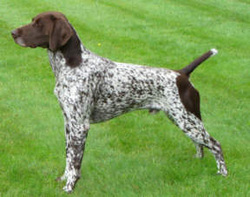DEUTSCH KURZHAAR ALSO FORMALLY NOW KNOW AS THE GERMAN SHORTHAIRED POINTER

The German shorthaired pointer (GSP) is a breed of dog developed in the 1900 century in Germany for hunting.
The breed is streamlined yet powerful with strong legs that make it able to move rapidly and turn quickly. It has moderately long floppy ears set high on the head. Its muzzle is long, broad, and strong, allowing it to retrieve even heavy game. The dog's profile should be straight or strongly Roman nosed; any dished appearance to the profile is incorrect. The eyes are generally brown, with darker eyes being desirable
HISTORY: The precise origin of the German Shorthaired Pointer is unclear. According to the American Kennel Club, it is likely that the GSP is descended from a breed known as the German Bird Dog, which itself is related to the old Spanish pointer introduced to Germany in the 17th century. It is also likely that various German hound and tracking dogs, as well as the English Pointer, also contributed to the development of the breed. However, as the first studbook was not created until 1870, it is impossible to identify all of the dogs that went into creating this breed.
The breed is streamlined yet powerful with strong legs that make it able to move rapidly and turn quickly. It has moderately long floppy ears set high on the head. Its muzzle is long, broad, and strong, allowing it to retrieve even heavy game. The dog's profile should be straight or strongly Roman nosed; any dished appearance to the profile is incorrect. The eyes are generally brown, with darker eyes being desirable
HISTORY: The precise origin of the German Shorthaired Pointer is unclear. According to the American Kennel Club, it is likely that the GSP is descended from a breed known as the German Bird Dog, which itself is related to the old Spanish pointer introduced to Germany in the 17th century. It is also likely that various German hound and tracking dogs, as well as the English Pointer, also contributed to the development of the breed. However, as the first studbook was not created until 1870, it is impossible to identify all of the dogs that went into creating this breed.

